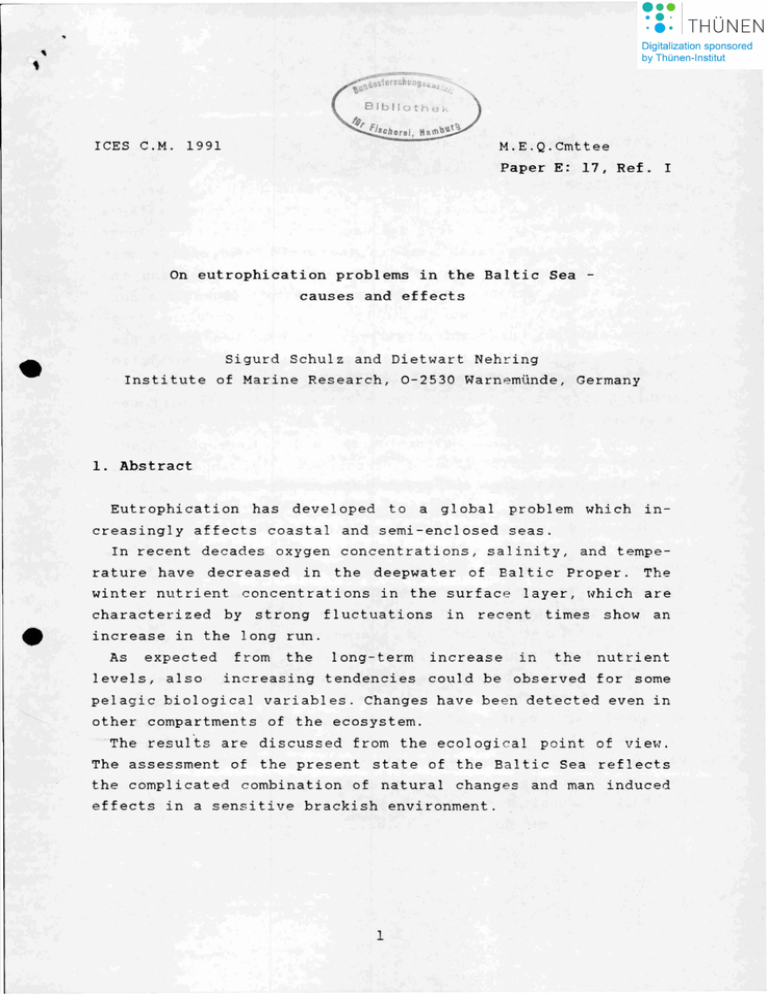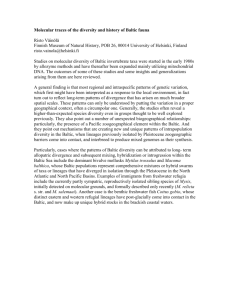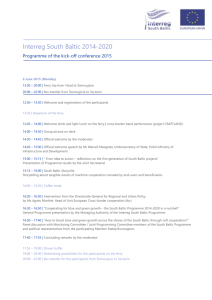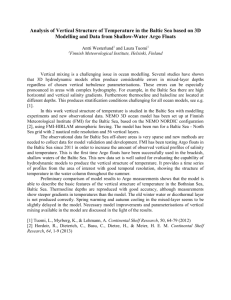,
advertisement

, \ leES e.M. 1991 M.E.Q.emttee Paper E: 17, Ref. I On eutrophication problems in the Baltic Sea causes and effects • Sigurd Schulz and Dietwart Nehring Institute of Marine Research, 0-2530 Warn~münde, Germany 1. Abstract Eutrophication has developed to a global problem which in- creasingly affects coastal and semi-enclosed seas. In recent decades oxygen concentrations, salinity, and temperature have decreased in the deepwater of Baltic Proper. The winter nutrient concentrations in the surface layer, which are characterized by strong fluctuations 4t in recent times show an the nutrient increase in the long run. As expected levels, also from the long-term increase in increasing tendencies could be observed for some pelagic biological variables. ehanges have been detected even in other compartments of the ecosystem. The results are discussed from the ecological point of view. The assessment of the present state of the Baltic Sea reflects the complicated combination of natural changes and man induced effects in a sensitive brackish environment. 1 , , 2. Introduction The BaI tic Sea is a semi -encl osed basin wi th a restricted horizontal water exchange. Due to its positive water balance which is caused by the large drainage area, the Baltic belongs to the greatest brackish seas in the world. One of its most important features is the permanent halocline restricting the vertical water exchange and dividing the water column in a surface layer with the lower salinity and the more saline deepwater. Below this discontinuity layer, stagnant conditions prevail in central BaI tic deep waters causing .. oxygen.consumption and the formation of hydrogen sulphide. • Episodic.influxes of highly saline water from theNorth Sea renew.the.stagnant deep water and improve the oxygen condition~. These m~jor inflows are connected with certain meteorological and hydrographie conditions, e.g. longer periods of strong westerly winds or gales generating a sea level difference between the Skagerrak and the western BalticSea. Since surface the Baltic Sea lies in the humid climatic zone, layer is characterized by seasonal hydrographie conditions, the nutrient variations distribution, its in the and the development of the biota .. Due to the heating in spring and summer a thermoclinc develops dividing the water column into thc warm surface layer and the cold intermediate water. This discontinuity layer disappears in the cold season. The Baltic Sea represents a unique brackish water environment wi th a long residence time of wa ter cal cul a ted wi th about 30 years. It is a geological young sea and exists in the present state only ab out 5000 years. Therefore, SEGERSTRALE (1957) has called it not yet "matured" what might partly explain the high variability in the system . The fauna and flora is composed.~by euryhal ine organismens wi th a high ecological capaci ty. Nev:~'r­ theless they live under physiological stress conditions which 2 ,;.,<" • result e.g. in lower diversity and generally in smaller size of the organismns compared with oceanic areas. All this features make the system very sensitive against natural changes and pollution. On the Research, basis of data obtained by the Rostock-Warnemünde, changes which are related to the eutrophication the present paper. Effects on Insti tute in the proce~s the other of Marine pelagic system are discussed in compartments of the ecosystem are compiled from the literature. In Fig. 1 the different areas of the Baltic Sea are shown . • 3. Long-term nutrient variations Monitoring data are available for phosphate covering a thirty year's period and for nitrate covering a twenty year's period in the Baltic Sea. With respect to eutrophication, nutrient trends in the surface layer are of high priority. Trend studies in this layer are restricted to the period of low biological activity, that me ans in winter and early spring, as long as light limits the phytoplankton development. Fig. 2 shows thatthe winter ni trate are • concentration~ increasing on average in the of phosphate and whol e period under investigation. The sub-trends indicate, however, that the positi ve overall-trends period 1969 - 1977. mainl y resul t In recent from times, the increase in the nutrient concentrations show strong variations, but do no longer increase on average. Theresults explained for stations in the eastern Gotland Sea are also valid for other sub-regions of the Baltic Sea Area (NEHRING, MATTHÄUS, 1990, HELCOM, 1990). Long-term trends for both phosphate and ni trate were al so identified in central Baltic deep waters below the permanent halocline, as long as conditions are oxic. Whereas the nitrate 3 sub-trends do not differ very much from the positive overalltrend shown in Fig. 3, the phosphate accumul~tion rate is decreasing in recent times. The situation is more complicated in the near-bottom water layer characteri:ed by alternating oxic and anoxie conditions. Due to denitrification nitrate concentrations decrease to zero during the transition from oxic to anoxie conditions. On the other hand phosphate is remobilized from the sediments in the prescnce of hydrogen sulphide. The rer:!ent stagnation period beginning in 1977 ü; the most serious one that has been observed in the Gotland Deep up to now. As in Fig. 4 shown, this period is characterized by the strong increase of phosphate and hydrogen sulphide concentrations.The increase of the last aneis reflected in the high negative oxygen equivalents. The recent salinity in central Baltic deep water is the lowest one that has been measured since the beginning of regul ar hydrographi c ohserva ti ons ab out 100 years ago. • 4. Long term changes in pelagic biological variables Although the available biological data cover a shorter time span than the chemical data, even remarkable tendencies might be discerned. For this assessment only the summer data from four different areas in the Baltic Sea have been used. In this season the system approaches astate of balance and shows therefore the lowest variabilty compared to other seasons (SCHULZ, 1985). In Fig. 5 the chlorophyll content is depicted as an equivalent for the phytoplankton biomass. Although the median values show a high degree of variabilty, in all areas an increasing tendency is visible. Without the last three years, which exhibit a clear decline, the increase would be statistical1y significant for all areas. Fig. 6 contains the data on in situ primary production. 4 4t In this ease the interannual variability is also very high, but the rising tendeney is even present. Cal eul ating the 1inear regression, the inerease was signifieant for all areas. The zooplankton biomass (Fig. 7) shows only for the last years a pronouneed inerease, whereas in the years before onl y minor ehanges eould be diseerned. 5. Diseussion • • The above mentioned ehanges in the pelagie~yst.em are obvi ous 1y cl osel y rel at ed. As eoul d be expeeted, "an inerease of nutrients should improve the growth of at least phytoplankton (SCHULZ, et al., 1985). But in most eases the nutrional eonditions improved also for the following biologieal eommunities in the food ehain. Phosphorus and nitrogen eompounds originating from natural and anthropogenie sources are the basis for this process and the reason for an increasing biologieal produetion, whieh regard to higher fish production, a positive effeet. The deterioration of the oxygen eonditions in stagnant deep waters eonneeting also wi th eutrophieation is however a serious and negative effeet of this proeess. The nutrients originate mainly from munieipal, agrieultural, and industrial sourees. They reaeh the sea by direet waste water input, by ri ver discharge and by air-borne transport. Mass balanees for the Baltie Sea also ineluding the wet and dry deposition from the atmosphere yield a gross input of 60 000-80 000 t phosphorus and 800 000 - 1 200 000 t nitrogen eompounds per year (MAXIMOVA, 1982, NEHRING, 1982, LARSON et al., 1985). These balanees are very rough beeause the quantitative statements are uneertain for some sources and sinks. o 5 ". ~ The air-borne deposition is roughly ealeulated to be 500 000 t inorganie nitrogen eompounds, whereas the atmospheric phosphate deposition is insignifieant. Generally the air-borne input of nitrogen eompounds seems to beeom~ more, iMportant in reeent deeades. Time seri~s have shown a ste~dy inerease of nitrate and ammonium eoneentrations in atmospherie ~'1et deposi tions over eentral Sweden (SEPA, 1990). After the period with the strong inerease between 1969 and 1977, the winter eoneentrations of phosphate and nitrate remain, on average, at their high levels in the surfaee layer of the Baltie Proper, but are eharaeterized by stronger fluetuations in recent times. Onere~son for the sometimec lower winter eoncentrations might be that, due to the earlier start of the spring bloom, the nutrient reserves were already eon~umed to a eertain extent by the phytoplankton before the m~asurements have been performed. Especiall y in the Bornholm Basin and the southern Gotland Sea, the bloom started very early after the last mild winters. If 'the inerease at least for the phytoplankton variables is still ongoing, several reasons should be responsible for this. At'first the nutrient input aets along the whole year and eannot , only be eonsidered from the winter values alone. The winter pool should mainly influenee the spring production, whieh for problems in timing of the observations and variability in the eommeneement of the bloom eould not be ineluded in this assessment. In this paper the summer values are used. It is weIl known that the rivers not in winter but in early'summer transport the largest fright of water and subsequent.ly nutrients to the sea. These nutrients should then enhanee the summer produetion. During this time the utilization of the nutrients is mueh more intensi ve than in spring beeause the pel agie eeosystem ap! proaehes the sum~erly stage with higher turnover rates of the nutrients compared with the other seasons of the.year (LEPPÄNEN, 1988). Also the air-borne input of nitrogen eompounds should cumulate in the warm season. 6 .. 4t • • In the discussion on eutrophication in the BaI tic Sea, the summerly blooms of the bluegreens and their contribution to the nutrient cycle by fixing molecular nitrogen play an irnportant part. Although their functioning especially with respect to the nutrient remineralization is not yet fully understood, one can expect that they are decayed under summer condi tions in the surface layer (HORSTMANN, 1975, SCHULZ, 1985). In every case the amount of phosphate left in the pelagic system after the spring bloom is decisive . other environmcntal signals might'~ause effects on the biological productivity and thenutrient ,distribution as weIl. It is weIl known that an increase in temperature activates metabolic processes and can thus enhance the productivity and the nutrient cycles. Additionally, periodic cycles of 3, 6 - 7 and 9 - 12 years and even longer are reported by KALEIS and OJAVEER (1990) and TRZOSINSKA (1990) for the Baltic Sea. These cycles are attributed to changes in the atmospheric circulation creating variations in the temperature regime as weIl as in the freshwater discharge. These variations are also reflected in nutrient cycl es producing periods of decreasing and increasing winter concentrations. One of the natural responses of the ecosystem to get rid of increasing nitrate concentrations is denitrifikation. This process counteracts eutrophication in the Baltic Sea. Budget studies account for a nitrogen 10ss of 470 000 t/a (RöNNER, 1985). This is roughly 90 % of the total input from the catchment arca and SO %, when the atmospheric deposition is also included. The'present analysis for the three biological variables in the peri6d 1976 - 1990 reveal beside the high degree of variability also some tendencies in relation to the progressing time. The course of the variables confirms in principle the increasing 7 tendency of previous analysis for the years 1975-1983 (SCHULZ et al., 1985, SCHULZ, KAISER, 1986). This increase is tor the three parameters differently pronounced and not over the whole time in~rease apparent. In the case of chlorphyll the 1987, wheras in cas e of primary product i on reversed after the t endency was clearly supported by the steaper rise after the low values of the years 1986/1987. The zooplankton biomass curve with the high values in the last years compensated the deep just before. In a previous paper (SCHULZ, KAISER, 1986) and the 3ubsequent assessment 1987), (HELCOM, primarily the nutrient supply and possibly oceanological increase in the pecularities of the • Baltic ecosystem as e.g. the natural leaning towards stagnation, the nitrogen input by bluegreens etc. were considered as pos- sible causes for the rising trends of the biological variables. The positive effect of nutrients to the phytoplankton productivity could be proofed experimentally in mesocosms also for the Baltic (SCHULZ 1985). et a1., In the experiments it. could be documented that aft.er a nutrient input not only the produetivity of the algae but also the duration of the bloom could be prolonged. This has, however, an important ecological implication, because it diminished the lap in the time scaJes between phytoand zooplankton development in spring. This me ans energy is stored in the surface layer and can that i~prove more the pro- duction eonditions also in summer. Beside our results from the pelagic system, which are con- firmed by other authors for different areas of the Baltic (HELCOM, 1990), signs for the eutrophi ation process are reported for other compartments of the Baltic ecosystem. the permanent haI oel ine an increase of benthos also Above hiomass was reported and related to the elevated pelagic productivity (HELCOM, 1985, 1990). Below the halocline a clear decrease was documented because of the oxygen decline. Another eutrophication is of some benthic red and the disappearance 8 consequence of • brown algae in shallow coastal areas and a shift to floating .. filamenteous plants. Partly the nutrient load but also the in- creasing turbidity due to the higher phytoplankton production is responsibl e for this devel opment. In this way, spawning substrate and nursery areas· for fish larvae and young fish are lost. Eutrophication might also be one reason for the appearance of "exceptional phytoplankton blooms". An example is the Chrysochromulina polylepis bloom observed in the Kattegat, Skagerrak, and northern North Sea~ in May 1988 (NIELSEN, RICHARDSON, 1990, HORSTMANN , JOCHEM, 1990) causing among others fish losses in mari cul tures (BORN' et al ., 1990). oceanographic condi tions. (doubl e Because layering in of the di f ferent summer, thermo- cline is not nutricline) in the Baltic, the probability of such bloom events canbe excluded for the open Baltic waters. A feat ure of the BaI ti c, however, is the mass occurance of bl uegreens. They might also form toxic events under certain circumstances (HELCOM, 1990). Remarkable changes have also taken place in the fish stock~ of the ecosystem. Total catches of the most important commercial fish species herring, sprat, and cod increased in the Baltic Sea from 450 000 t in 1965 to 900 000 t in 1980 according to ICES statistics. This is partly due to the increasing fishing effort 4t but also induced by improved nutritional conditions for young and adult fish and subsequently higher growth rates. This could be proved for young herring (RECHLIN, 1984). The mentioned fish stocks are ,however,in nutrional relation e.g. the clupeids are food for cod. Variations in one stocks change automatically the balance. The decrease in cod, as observed in recent times, influences the clupeid stocks generally positively. On the other hand,' the environmental conditions do not only influence the . stock size but also the recruitment success. 9 The decrease in this respect especiaIIy for cod is not only caused by the unfavourable oxygen condition but also by the extremely low salinity in Baltic deep waters injuring the fertilization of the cod eggs (WESTIN, NISSLING, 1991). The recent nutrient pool in the Baltic Sea and the resulting organie produetion and sedimentation of organic matter burden the oxygen conditions near the bottom. In late summer· and autumn, this process is sometimes strenghened by the low oxygen eoneentrations of the inf 1 owing deep/.water. Hydrogen sulphide eoneentrations are inereasing in eentral BaI tic deep waten~. Fig. 8 shows the areas which arevery often affeeted by lOH' oxygen eoncentrations and anoxie conditions in the near- bottom water layer. Oeeasionally, anoxie eonditions are.also observed in the relatively shallow Mecklenburg, Lübeck, and Kiel Bays as weIl as in the southern Kattegat. Even when the deep Hater eontains oxygen, the transition zone between water and sediment is often anoxie in late summer and early autumn. The deterioration of the oxygen eonditions restriets the living space of benthie organisms including demersal fish. • 5. Conelusions The present status of the Baltic Sea indieates that eutrophieation and its consequenees are proofable for all compartments of the ecosystem. The reaction of the biota to this process is an increase in the productivity of th~ organisms living in the weIl aereted surtace water. No clear ehanges have been identified in the species eomposition up to now. The opposite development must be stated tor the communities living in the deeper parts·of the Baltic Sea. Below the halocline serious impoverishment at the speeies level and deerease in biomass has taken place due to the deterioration of the'oxygen eonditions; ·This is valid expecially for the benthie community. 10 .. • The causes for the eutrophication are primarily the continuation of nutrient inputs into the system. However, the special oceanological condi tions in the BaI tic characterized by the restricted horizontal and vertical water exchange should not be disregarded in this respect. Furtheron the climatological changes taking place, especially the global heating, must· be considered. Thus, the changes observed in the Baltic Se3 are the combination of different causes. This makes the decisions finding very difficult and uncertain. It is, however, a weIl proofed fact that the man induced nutrient input into the sea creates at least a considerable part of the problems. The decision of the Baltic States to reduce the input of pollutants to 50 % until 1995 is therefore a good message for the Baltic ecosystem. 6. Literature • BOKN, T., BERGE, J.A., GREEN, N., RYGG, G., 1990. Invasions of the planktic algae Chrysochromulina polylepis along south Norway in May - June 1988: Acute effects on biological communities along the coast. - Commission of the European Communities. Water PoIl. Res. Rep. 12, 183 - 193 . HELCOM, 1987: First periodic assessment of the state of the marine environment of the Baltic Sea Area, 1980-1985. Background Document. - Baltic Sea Environ. Proceed. 17 B: 1 - 351. HELCOM, 1987. First Baltic Sea pollution load Baltic Sea Environ. Proceed. 20, 1 - 53. compilation. HELCOM, 1990. Second periodic assessment of the state of the marine envi ronment of the BaI ti c Sea Area, 1984 - 1988. Background Document. - Baltic Sea Environ. Proceed. 35 B, 1 - 428. 11 HORSTMANN, U., 1975: Eutrophication and mass production of bluegreen algae in the Baltic. - Havsforskningsinst. Skr. 239: 83 - 90. HORSTMANN, first bloom Water U., JOCHEM, F., 1990. Report of the activities and results of the investigations on the Chrysochromulina in FRG. - Commission of the European Communi ties. PoIl. Res. Rep. 12, 75 - 92. LARSSON, U., ELMGREN, R., WULFF, F., 1985. Eutrophication and the Baltic Sea - causes and consequences. - Ambio 14, 9-14. LEPPÄNEN, J. -M., 1988: Carbon and ni trogen cyc1 es during the vernal growth period in the open northern Baltic proper. Meri 16: 1 - 118. • MAXIMOVA, R.M., 1982. The balance of biogenie elements and organic matter in the Baltic Sea during intensive anthropogenie effects. - Okeanologija ~2, 751 - 756 (in Russian) . SCHULZ, S., 1985: Ergebnisse ökologischer pelagischen ökosystem der Ostsee. Rostock-Warnemünde: 1 - 185. Untersuchungen im Prornot. B-Schr., SCHULZ, S. and W. KAISER, 1986: Increasing trends in plankton variables in the Baltic Sea - A further sign of eutrophication? - Ophelia, Suppl. 4: 249 - 257. SEGERSTRALE, S., 1957: 67: 751 - 800. Baltic Sea.- Mem. Geol. Soc. America • 12 • Fi 1· /( The subareas of the Baltic Sea O. 8 ~----------------------------:.:-0---I pmol/dm 3 0.7 Q6 • 0 '" 0.5 ... c 0.4 0.3 ~. Sial. BY 15A SIal. BY 11 B Sial. BY .10B Sial. SY· 9A Sial. ses 111 10 SIal. SY. BA "'. . . ... .'" . • •• .~ ~ .... 0160 i J "'0 ~ 0 ~ 0-_", • 0 ~ '10 • • -.... '" -..P '" - ~ et __ t-.", i rJ . "'1~ ... _ . . . ---, 11 '.l.di. '" "'... .0 '" 1'" \ '" ~ t &J I 0.2 ... "'Z-. P0 4 3Jan.-Apr. • g... % 0.1 0 1960 1958 1965 1990 6 I pmol/dm 3 (.1 5 . . '" ~d '" ~ 4 ",. !' .3-t - . 3 2 1 • - • '" 0 '!-"" -, 0 •'" '•" 1- 0 1965 • 1970 '" • '" ~ '" ~c •'" c'" . • aa .t:I "• • • 1975 19 0 8.25,-r----------------------------,~-----__, ·1•• • 8.00 • 7,75 • 7.50 • ~.-.-p ~ S • Jan.-Apr• ~·~:.·--r-r--.-__r__,-,.__,:__r-r__r_.___,r_.,__r_,-,.___r_r-I,--,_,I,._I_r-I_,____j 7,25-+---'-----':.6.971 1985 1990 1958 1960 1965 1970 1975 1980 Fig. 2 Trends in the winter surface layer of the south eastern Gotland Sea 5-r----...:--------------------- pmol/dm 3 4' P043Stat.BY 15A 3 100 m 2 ..., .•., . '-•....e: . - ...;..•• ...,.': .a-- ~~~~~ • . .- i'e • •• 12'-r-------------------pmol/dm 3 10 • • •• 2 • • • • .-.. · .. ...-..-. . .• .4... ...., _______ .~ • ob ..-;, - •••'.~ u'. •• •• e. ..,,-::...-.-::-_. ••• 6 • • \e .- • 4 .. . . .,., ...,. • 8 ---, ~ • • • • 1·1 1990 • • •• , • •• ..• .• - s=: __ • :... • • • 0 1960 12,0 0/00 • 1965 .. , . • •• • .. .-.;"..t.. • •• --- . , . , .. ..••........'.- . .... ---.--. , e.. ... .,. . •••• .., S • • 11.5 • •• 11.0 10.0 • • ,. , • • • ~ • •• 10.5 1990 • "- •••••• • .. . . - . -• ;-. • • \ •• • • • 9.5 1960 1965 1970 1975 1980 1985 Fig. 3 Trends in the deep water (100 m) of the Gotland Oeep 1990 r 10 • jJmol/dm 3 • • 8 •• 6 •• P043- -• • • - ---- 2 •• . -..-....... / .. ••• •li., • --"- 4 StaLBY15A 200m - • ~ • • 1.1 1.) -.,. • • - ·1•• ------ - S • • - 12.5 12.0 . (-I 1985 1990 -l-~ - _I-I - - -.~ ---- ,.• • -- - - - • H2 S - - 0 2 1960 13.0 1980 - - -3 - ... ~ .~- 1-' -2 -4 • ••• 1975 02 ~ -- •.-1' ••- 1960 2 I cm 3/dm 3 ..-_..- 1965 =.., --- -- '-I 1975 1970 1990 1-. -~ -• . -..•• ••• •• • 11.5 1960 1965 Fig. 4 Trends in the near-bottom water layer (200 m) of the Gotland Oeep 1990 • - 100 • N I 69 e 11 - f- 4lI ~ tJl E 8 '"-----'---'---'--'--'-..........................L-....L-..&..-.J..-.L--.L--L..-.....l76 77 78 B8 81 82 83 84 85 86 87 88 89 98 9 '----'--'--'--'--'-..........................L-.........J..-.J..-.L--""----''---' 76 77 78 Ba 81 82 83 84 85 86 87 88 89 98 llOlNlOl.M SEA 60TlfIID SEA 100 + B 11 • 01 E 4e 20 - 29 ~ 76 77 7S 88 81 82 83 84 85 86 87 88 89 98 ~'EAR +I'S' S2 The variability of chlorophyll concentrations (mg.m- ) in the uppermost 0 - 30 m layer of the different areas of the Baltic Sea in summer. The central box covers the middle 50 \ of the data values, between the upper and lower quartiles. The central horizontal line represents the median. The "whiskers" extend to the maximum and minimum values. Extrema are plotted as separate points. APJ<1Bl SEA !'ECI<\.EHBI.Ri BIGHT O( 100) 24 I- .. - 100) 24 281- - 29 • 16 N I 12 '- • 81- I 'U F 0 (X 16 I- ~ 4- 01 e 9 ... g 0· , f 9$ ~ ~ 76 77 80 81 82 83 84 85 86 87 88 89 98 - 12 - 8 - 4 _~8BD~~~~8$8 B • ... 9 76 77 7S 00 81 82 83 84 85 86 87 88 89 90 SOTLAHD SEA (X l00)r----r--r-......-...,.--.--.....--....--,.-,r--r--r--.----.--....-":;(X l00).----....-r--r-~...,.-.....-.....--....--,........,,...-.,---r--.--.---.. .. I 'U M - .g 29 25 - 28 r1 B Ii - 15 • 16N ~ 12 u• 8 1I 4 E - B 9 ~ r t1 B~ t - 9 10 5 76 77 78 B8 81 82 83 84 85 86 87 S8 89 90 YEM The long-term variability of summer primary production values -2 -1) (mg C.m.d in different areas of the Baltic Sea .. ~ • ARKlHl SEA /'ECKl..EHIllJl6 BllifT 21- 2 1.6 - 1.6 l- 1.2 - 1.2 ~ n I e e I ...e 9.8 9.4 I- 91- E1~gB~allBagQg~+ 9.8 - 9.4 - 9 76 77 7S 80 81 82 83 84 85 86 87 88 89 90 n 76 BOOHHOUI SEA 2 2 1.6 1.6 -~ e 1.2 I • 8.8 9.4 QeDB$~-e~ 0 9 89 99 - 1.2 I8.8 f- 9.4 I- B - ~ 9 76 Tl 7S Be 81 82 83 84 85 86 87 88 89 90 YEAR es OOMlll SEA t'I I ...E 7S 00 81 82 83 84 85 86 87 76 n 78 Be 81 82 83 84 85 86 87 88 89 99 YEAR +:'s· + The variability of mesozooplankton biomass (ml.m- J ) for the surface layer (0 - 25 m) in the different areas of the Baltic Sea 59 59· H 2 S: Mai 1982 mm3 Mai u. Ok I.INov. 1982 1111111 Ok1.lNov.1982 2cm 3 /dm 3 : M~u.Okt/No~1982 0' OkUNov.1982 S7" Fig. 8 Areas with low oxygen concentrations and hydrogen sulphide in the near-bottom water layer 57" e •





